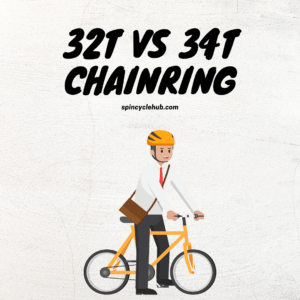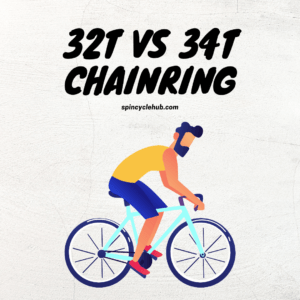Introduction
Exploring the World of Chainrings
Picture yourself cruising down a picturesque cycling route, feeling the wind in your face and the thrill of the ride. As a cyclist, you know that every component of your bike plays a vital role in your overall performance. One component that often sparks a spirited debate among riders is the choice between a 32T and 34T chainring. In this article, we’ll delve into the intricacies of chainrings and help you navigate the 32T vs 34T dilemma to find the perfect gear for your ride.
What is a Chainring?
The Backbone of Your Drivetrain
Before we dive into the debate, let’s take a moment to understand what a chainring is and why it matters. A chainring is a circular metal plate with teeth that is mounted to the crankset of your bicycle. Its primary purpose is to transfer the power from your legs to the rear wheel through the chain, enabling you to propel forward. The size of the chainring and its teeth count play a significant role in determining your gear ratios and shifting capabilities.

The Basics of Teeth Count
Unraveling the Gear Ratio Mystery
To comprehend the 32T vs 34T debate, we need to grasp the concept of teeth count. The number of teeth on a chainring directly influences your gear ratio. A smaller chainring, like the 32T, provides easier climbing and improved torque, making it well-suited for hilly terrains. On the other hand, a larger chainring, such as the 34T, offers higher top-end speed and a smoother cadence, which is advantageous on flatter roads and during sprints.
Exploring the 32T Chainring
Conquer the Climbs with Ease
Let’s zoom in on the 32T chainring. This option features a smaller diameter and fewer teeth, making it a favorite among climbers and those who enjoy tackling steep hills. The 32T chainring offers a lower gear ratio, allowing you to maintain a steady cadence and conquer challenging inclines with relative ease. However, it’s worth noting that the smaller size may limit your top-end speed and slightly compromise power transfer efficiency on flat terrain.
Diving into the 34T Chainring
Unleash Your Inner Speed Demon
Now, let’s turn our attention to the 34T chainring, which boasts a larger diameter and more teeth. This chainring is a popular choice for riders who prioritize speed and enjoy pedaling at a higher cadence. The 34T chainring provides a higher gear ratio, enabling you to achieve greater top-end speed on flat roads and during sprints. However, it may present challenges when climbing steep hills due to the reduced mechanical advantage and increased difficulty in generating torque.
Factors to Consider When Choosing a Chainring
Finding Your Perfect Fit
When it comes to selecting the ideal chainring, several factors should influence your decision. First and foremost, consider your fitness level and strength. If you excel at climbing or have strong leg muscles, a 32T chainring might be an excellent choice. Alternatively, if you prioritize speed and prefer a faster cadence, the 34T chainring could be more suitable.
Terrain also plays a crucial role. If you frequently encounter steep hills and challenging ascents, a 32T chainring can provide the low gearing necessary for successful climbs. However, if your rides predominantly involve flat or rolling terrain, the 34T chainring’s higher gear ratio may be more advantageous.
Lastly, personal preference and comfort should not be overlooked. Each cyclist has unique riding goals and preferences. Some riders thrive on the feeling of conquering challenging climbs, while others relish the adrenaline rush of reaching high speeds. Consider what type of riding brings you the most joy and align your chainring choice accordingly.
Real-Life Experiences and Anecdotes
Insights from the Trenches
To provide you with a well-rounded perspective, let’s delve into the experiences of cyclists who have chosen either the 32T or 34T chainring. Cyclists who prefer the 32T chainring often highlight the ease of climbing steep hills and the ability to maintain a comfortable cadence. On the other hand, enthusiasts of the 34T chainring rave about the exhilarating speed achieved on flat roads and the seamless cadence during sprints.
Making the Decision
Weighing Your Options
Choosing between a 32T and 34T chainring ultimately comes down to your personal circumstances and riding style. Evaluate your fitness level, the terrain you typically encounter, and your overall riding goals. It’s also worth consulting with experienced cyclists or professionals at bike shops for additional insights and recommendations. And remember, don’t be afraid to experiment and try out different chainring sizes to find the perfect fit for your cycling adventures.
Conclusion
Finding Your Cycling Sweet Spot
As you embark on your cycling journey, the choice between a 32T and 34T chainring is a decision worth considering. Understanding the impact of teeth count and gear ratios can empower you to make an informed choice that aligns with your unique needs and preferences. Whether you opt for the 32T chainring to conquer climbs or the 34T chainring to unleash your speed demon, remember that the joy of cycling lies in finding your sweet spot—the gear that makes every pedal stroke feel just right.

FAQs
Answers to Your Burning Questions
Q1: Which chainring is better for climbing steep hills?
A1: The 32T chainring is generally more favorable for climbing steep hills due to its lower gear ratio and improved torque.
Q2: Can I switch between a 32T and 34T chainring easily?
A2: Switching between chainring sizes is possible but may require adjustments to the front derailleur and chain length.
Q3: Does the chainring size affect chain wear and durability?
A3: The chainring size itself does not directly impact chain wear or durability. Proper chain maintenance and regular replacements are more influential factors.
Q4: How can I determine the ideal chainring size for my riding style?
A4: Consider your fitness level, terrain preferences, and riding goals. Experimentation and seeking professional advice can also help you find the ideal chainring size.
Q5: Are there any other factors to consider when choosing a chainring?
A5: Besides teeth count, factors like your bike’s drivetrain compatibility, gear range, and overall component selection should be taken into account when selecting a chainring.
- Cycling Weekly – How to Choose the Right Chainring Size This article from pandapodium offers insights into selecting the right chainring size for your cycling needs. It provides a comprehensive guide on factors to consider and offers expert advice to help you make an informed decision.
- Global Cycling Network (GCN) – Gear Ratios Explained This YouTube video by Global Cycling Network (GCN) dives into gear ratios and explains how different chainring sizes can affect your cycling experience. It offers visual demonstrations and explanations to help you understand the concept in an engaging and informative manner.
Watch this one,
Video Credits – maetsuen
DOWNLOAD THIS ARTICLE :Click Here
You May Also Like
-
IBIS S35 Carbon Wheels Review: Unleashing the Power of Performance
-
CushCore XC vs. Pro: The Battle of Mountain Bike Tire Inserts
-
29er Frame with 27.5 Wheelset: Blending the Best of Both Worlds




